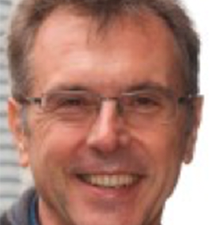 Prof. Sotirios Pratsinis
Prof. Sotirios Pratsinis Sotiris E. Pratsinis is Professor of Process Engineering & Materials Science at ETH Zurich, Switzerland. He has a Diploma from Aristotle University of Thessaloniki, Greece and MSc and PhD from Univ. of California, Los Angeles. At ETH Zurich he teaches Mass Transfer, Micro- and Nano-Particle Technology and Introduction to Nanoscale Engineering. His research focuses on particle dynamics and aerosol synthesis of catalysts, gas sensors and biomaterials funded by the European Research Council, the U.S. and Swiss National Science Foundations, Swiss Commission for Technology and Innovation as well as by Dow, DuPont, Clariant, Degussa, Nestle, Siemens, Toyota etc. He has graduated 38 PhD students (now at leading academic and industrial positions worldwide), published 400+ refereed articles, filed 20+ patents that are licensed to industry and have contributed to creation of four spinoffs. ...more on his web page linked here: http://www.ptl.ethz.ch/people/person-detail.html?persid=79969
The lecture will start with an overview of aerosol technology for today’s manufacture of consumer products (optical fibers, fumed SiO2, pigmentary TiO2 and carbon black). Recent advances in understanding particle formation and growth through discrete element modeling and molecular dynamics allow now optimal process design capitalizing on the rapid attainment of asymptotic (fractal-like) agglomerate structure and self-preserving size distribution by coagulation1 as extremely high aerosol concentrations are handled at short residence times.
This leads to scalable synthesis of sophisticated nanoparticles (up to kg/h even in a university lab) with controlled composition, size and morphology by flame spray pyrolysis. So new high value products (e.g. nanosilver and carbon-coated Co nanoparticles) enter the market already while several promising ones are emerging such as chemoresistive sensors for breath analysis that could sniff–out earthquake victims2 and single atom photocatalysts3 that would be discussed as time permits. Reducing the particle size of noble metals on ceramic supports can maximize noble metal performance and minimize its use. Here Pd clusters onto nanostructured TiO2 particles are prepared in one step by scalable flame aerosol technology while controlling the Pd cluster size from a few nanometers to that of single atoms. Annealing such materials leads to photocatalytic NOx removal in a standard ISO reactor up to10 times faster than that of commercial TiO2 (P25, Evonik). Such superior performance can be attained by only 0.1 wt% Pd loading on TiO2.
1. Aerosol-based Technologies in Nanoscale Manufacturing: from Functional Materials to Devices through Core Chemical Engineering, AIChE J., 56, 3028 (2010).
2. A.T. Güntner, N.J. Pineau, P. Mochalski, H. Wiesenhofer, A. Agapiou, C.A. Mayhew, S.E. Pratsinis, Sniffing Entrapped Humans with Sensor Arrays, Anal.Chem. 90, 4940-5 (2018).
3. K. Fujiwara, S E. Pratsinis, Single Pd atoms on TiO2 dominate photocatalytic NOx removal, Appl.Catal.B: Environ., 226, 127 (2018).